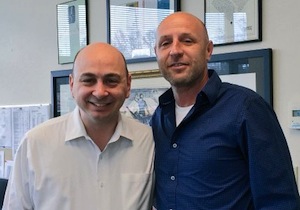LeadWith’s leadership team at one of the organization’s events, left to right: co-founders Shira Weinberg and Dalit Heldenberg and managing director Aviv Ziv. (photo by Hadas Eldar Photography)
STEM-related women’s groups are popping up all over the world – and Israel is no exception. In fact, the country is a leader in this area.
Shira Weinberg and Dalit Heldenberg co-started LeadWith, a group for women like them – women interested in STEM (science, technology, engineering and math) and seeking camaraderie.
Weinberg, a senior product manager at Microsoft, started out as a software developer while in the Israel Defence Forces’ marine core, and then worked and studied as a software engineer for five years. She’s been with Microsoft for nine years, first as an engineer and then as a product manager.
“As a woman in the industry, I always felt like there aren’t many women,” said Weinberg. “At the beginning, I got used to it and I figured that’s how it is in this area and that’s OK. But, after a few years in the industry, I realized it doesn’t have to be like that.
“That’s one of the reasons I started LeadWith, and I’m also doing some other stuff related to promoting girls and women in the tech industry.”
Raised by a father who worked in the industry in Herzliya, Weinberg was much more familiar with computers than were most of her friends. She went into computer science in high school, which paved the way to her position in the IDF.
Like Weinberg, Heldenberg also started her career as a software engineer. “As a kid, I was always attracted to computers more than the others,” said Heldenberg. “I knew that this is what I wanted to learn, computer science.”
Both young women feel strongly that there is no reason the gender gap should be as big as it is today.
“As you look higher and higher in management positions, there are fewer women,” said Weinberg. “This is something we want to change. And this is one of the main reasons I wanted to lead this change.”
Heldenberg added, “Even when I studied computer science, I’d always see too few women in this field. When I was learning high school physics and when I studied computer science, I was always missing women. We want to see more women wanting to be in management roles.”
Weinberg and Heldenberg understand that, in order to create this change, they need to provide mentorship to other women. They now have bi-monthly get-togethers that include networking and education sessions.
“We found a lot of demand from women for these kinds of events,” said Heldenberg. “At the first event, we weren’t sure how many women would come. We planned for about 50, but ended up with 200 attendees.
“We are currently doing three types of activities. One, the meet-ups, where we usually have 100 to 200 women come.
“We also have the mentoring program, where we hold events also every two months. The mentoring events are smaller in terms of size, but we have our team of mentors all volunteering and joining in for the events. We hold sessions of one-on-one mentoring conversations for around 30 minutes…. For each mentoring event, we have about 25 mentees.”
The third activity is an accelerator program for women entrepreneurs who are at the end stages of launching their start-up. In the first program, they had 13 entrepreneurs. It involved nine full days of sessions over nine weeks, with each day focused on different tools relevant to entrepreneurs.
“At the end, we had a big demo day with important people in the industry,” said Heldenberg.
With more than 1,600 people now involved with LeadWith, it is clear that they are filling a previous void and that their approach is working.
“At the events, we put a lot of focus on networking,” said Weinberg. “We usually have a short networking session before the main session begins. We make sure every woman will talk with one or two women she hasn’t met before … that really helps them know more women in the industry and creates more conversations.
“Always after these kinds of events, you hear good stories about things that happen because of the networking and the new connections. Of course, you get to know other women in the industry.
“Also, at the time when a woman wants to change roles, she can draw upon the extensive connections she has gained at our events. You can never know what will come out of this kind of connection. We always hear great stories.”
LeadWith’s focus is both on connecting women who are already in the industry, as well as those who studied computer science or technology but, for one reason or another, did not go on to work in the field. The organization hopes to draw these latter women back into the field.
“A month ago, we did a hackathon in collaboration with another organization, called Cyber Girls,” which brings computer science to those around 16 and 17-years old, said Weinberg. “They brought the girls and we brought the women, and we divided into teams that included both women from the industry and the girls. It was a few hours. There were multiple teams. Each team had a big mission and a lot of tasks along the way – quizzes and such – to figure out solutions that involve writing code.
“What was amazing was that each team in this hackathon was … 10 teenaged girls and a woman from our community, and the quizzes they had to do were really tough. The young girls were very ambitious, they couldn’t get the answers from us. It was really good to see that. They are very smart.”
LeadWith is a nonprofit organization and volunteers are an integral part in whatever they do, said Heldenberg. “We get some help in posting events in certain offices, [donations of] snacks and drinks for events, those kinds of things, from Microsoft, Google and Wix.”
Both Heldenberg and Weinberg think there are multiple reasons for the lack of women in STEM fields, from how children are raised, the educational system and society as a whole. They also are concerned that, if they spread themselves too thin, they will achieve less. As such, they have opted to focus, for now, on industry women in their 20s to 40s. For more information, visit leadwith.org.
Rebeca Kuropatwa is a Winnipeg freelance writer.




